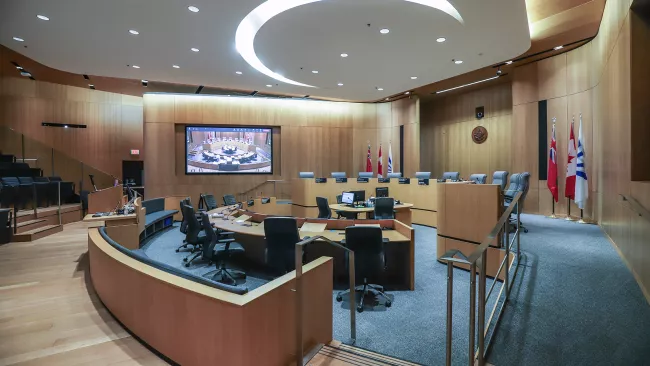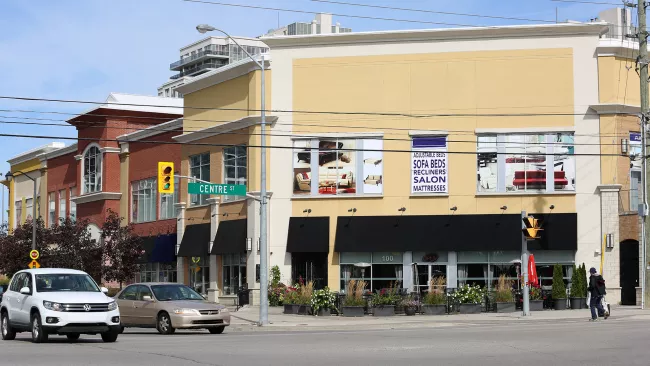From the Archives
Toronto Purchase of 1805 (Treaty No. 13)
The City of Vaughan’s archives house more than 600 collections dating from the early 1700s to the present day. Within these files are the stories of how Vaughan evolved from the traditional territories of the First Peoples of Turtle Island to the bustling city it has become.
Let’s look back at our history and share the stories of the people, places and moments that helped shape the city we know today. This month’s feature is on the Toronto Purchase of 1805 (Treaty No. 13).
In the late 1700s, the British Crown was pressured to find land for resettlement in their territories following the arrival of loyalists in Kanata (which is the present-day Canada) during and after the American Revolutionary War. Among the loyalists were about 2,000 members of the Six Nations of the Grand River, who feared persecution and had their homes taken by the Americans.
Seeking to reward their Indigenous allies for their loyalty during the war, the British offered homes to the Six Nations of the Grand River refugees in Kanata. One group settled at the eastern end of Lake Ontario, while another, under the leadership of Mohawk Chief Joseph Brant, selected the Grand River Valley area.
In 1787, Sir John Johnson, the head of the Indian Department (now known as the Crown-Indigenous Relations and Northern Affairs Canada department), called a Council meeting at the Bay of Quinte to distribute trade goods as a reward to the Mississaugas of the Credit First Nation. The Mississaugas of the Credit First Nation are part of the Ojibwe (Anishinaabe) Nation, one of the largest Indigenous Nations in North America. The Mississaugas of the Credit First Nation exchanged goods with British fur traders who would extend credit to the Mississaugas and then be paid back the following spring. Before the land was occupied by the Mississaugas of the Credit First Nation, the area we now know as Vaughan was the traditional home of the Huron-Wendat Nation.
At the 1787 Council meeting, Sir Johnson also discussed several potential land sales along the north shore of Lake Ontario, and, in particular, the potential purchase of Carrying Place from Toronto to Lake Simcoe. Although these discussions were later viewed as the sale of Toronto, with the trade goods being wrongly characterized as payment for the Toronto Purchase, nothing was sold at the Council meeting. The land deed itself was blank and had no description of the land being purchased by the Crown. Crown administrators soon began to doubt the legality of the original Toronto Purchase Treaty and were concerned that many settlers did not have legal title to their homesteads. To rectify the situation, on Aug. 1, 1805, the Crown purchased 250,830 acres of land for the sum of 10 shillings (less than $150 Canadian in today’s market), while the Mississaugas of the Credit First Nation reserved for themselves the right to exclusively fish on Etobicoke Creek.
The City of Vaughan has proclaimed June to be National Indigenous Month. This is an opportunity to recognize and learn about the traditions, languages, art, music, storytelling and histories of First Nations, Métis and Inuit people across the country and promote truth and reconciliation with Indigenous communities.
LAND ACKNOWLEDGMENT
We respectfully acknowledge that the city of Vaughan is situated in the Territory and Treaty 13 lands of the Mississaugas of the Credit First Nation. We also recognize the traditional territory of the Huron-Wendat and the Haudenosaunee. The city of Vaughan is currently home to many First Nations, Métis and Inuit people today. As representatives of the people of the city of Vaughan, we are grateful to have the opportunity to work and live in this territory.
VIEW VAUGHAN'S ARCHIVES ONLINE!
Looking for more information about the history of Vaughan? The City's Archival Collection is on digital display for all to explore! The below galleries are available in the City's online gallery on Flickr:
- Archival Awareness
- Early Churches of Vaughan
- Early Communities of Vaughan
- Early Pioneers of Vaughan
- Families in Arms
- From Township to City: The Evolution of Vaughan
- Historical Families of Vaughan
- Historical Photography
- Recollections of Rural Vaughan
- The Mary Wood Collection
- The Way We Were: Representations of Vaughan's Past
- Vaughan’s Forgotten Heroes
- Vaughan Lodge Fonds
- Vaughan Working Environments
- Vaughan Through the Ages: Medicine, Music and Sports and Recreation
- And more!
A personal Flickr account is not required to access the City's online gallery, which contains only a small selection of the full archives collection. If you are looking for a particular image, original file, primary source record or more, please visit the Archival Database or contact the City by calling 905-832-2281 or emailing archives@vaughan.ca.
By managing and preserving both City and community records, the City’s Enterprise Information Management Services team ensures that Vaughan's rich and varied history will continue to be available for future generations. Learn more at vaughan.ca/archives.
For the latest updates, subscribe to Vaughan News and follow the official corporate channels on X, Facebook, Instagram and LinkedIn.





